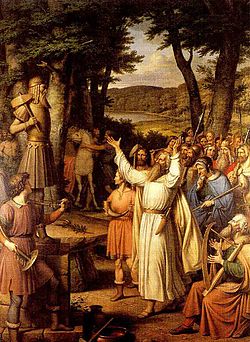Gothi

Gothiorgoði(pluralgoðar,fem.gyðja;Old Norse:guþi) was a position of political and social prominence in theIcelandic Commonwealth.The term originally had a religious significance, referring to apaganleader responsible for a religious structure and communal feasts, but the title is primarily known as a secular political title from medievalIceland.
Etymology
[edit]The word derives fromgoð,meaning "god".[1]It possibly appears inUlfilas'Gothic languagetranslation of the Bibleasgudjafor "priest", although the corresponding form of this inIcelandicwould have been an unattested*gyði.[2]InScandinavia,there is one surviving attestation in theProto-Norse formgudijafrom the Norwegian Nordhuglorunestone(RundataN KJ65 U),[3]and in the later Old Norse formguþifrom three Danish runestones: DR 190 Helnæs, DR 192 Flemløse 1 andDR 209 Glavendrup.[4]There are a few placenames, such asGudbyinSödermanland,Sweden, that probably retain the name.[5]Otherwise, there are no further surviving attestations except from Iceland where thegoðarwould be of historical significance.[2]
History
[edit]Mainland Scandinavia
[edit]Ragnhildr placed this stone in memory of Alli the Pale,guþiof thesanctuary,honourableþegnof the retinue.
Inscription from theGlavendrup stone[6]
From the pagan era in mainland Scandinavia, the only sources for the title are runestones. The Norwegian Nordhuglo stone from around AD 400 seems to place the title in opposition to magic, using a word related to the Old Norsegandr.The inscription'sEk gudija ungandizmeans "I,gudija"followed by" he who is immune to sorcery "or" he who does not engage in sorcery ".[7]The three Danish stones are all fromFunen.The earlyViking AgeHelnæs and Flemløse 1 stones provide no details about the function of aguþi,but mention aguþinamed Roulv whose name also appears on two other runestones, the lost Avnslev stone and the Flemløse 2 stone. The early 10th-centuryGlavendrup stoneuses the term for a local dignitary who was associated with avé,which is a religious structure. It thus attaches the title to a simultaneouslysecularandreligious upper strata.[4]
Iceland
[edit]The most reliable sources about thegoðarin Iceland are theGray Goose Laws,theLandnámabókand theSturlunga saga.After thesettlement of Iceland,ahofgoðiwas usually a wealthy and respected man in his district, for he had to maintain the communal hall orhofin which community religious observances and feasts were held. The office over which agoðihad leadership was termed agoðorð,a word that only appears in Icelandic sources.[1]Initially many independentgoðorðwere established, until they united under theAlthingaround 930. In 964, the system was fixed under a constitution that recognized 39goðorð.The role of thegoðaras secular leaders is shown in how the word was used synonymously withhöfðingi,meaningchieftain.Over time, and especially after 1000, when theChristian conversion occurred in Iceland,the term lost all religious connotations and came to meanliege-lordor chieftain of the Icelandic Commonwealth.[2]Agoðorðcould be bought, shared, traded or inherited. If a woman inherited agoðorðshe had to leave the leadership to a man.[1]The office was in many respects treated as private property but was not counted as taxable, and is defined in the Gray Goose Laws as "power and not wealth" (veldi er þat en æigi fe); nevertheless thegoðarare frequently portrayed in thesagasas concerned with money and expected to be paid for their services.[1]
During the Icelandic Commonwealth, the responsibilities of agoðiorgoðorðsmaður( "goðorðman ") included the annual organization of the local assembliesvárþingin the spring andleiðin the autumn. At the national Althing, they were voting members of theLögrétta,the legislative section of the assembly. When quarter courts were introduced in the 960s, thegoðarbecame responsible for nominating judges for the Althing courts. When a court of appeals was established in the early 11th century, they also nominated judges for this court. Further, they had a few formal and informal executive roles, such as confiscating the property of outlaws. They also had a central role in theredistribution of wealth,by holding feasts, giving gifts, making loans, extending hospitality, as well as pricing and helping to distribute imported goods.[1]The holder of thegoðorðof the descendants ofIngólfr Arnarson,the first Scandinavian to settle permanently in Iceland, had the ceremonial role of sanctifying the Althing each year, and was called theallsherjargoði( "all-peoplegoði").[8]The followers of agoðiwere calledþingmenn.Everyfree landownerin possession of a certain amount of property was required to be associated with agoði,although he was free to choose which one—agoðorðwas not a geographical unit—and the contract could be canceled from either side. Thegoðiwould help hisþingmennto bring cases before the court and to enforce their rights, and theþingmennwould in return provide thegoðiwith armed manpower for his feuds and carry out legal sentences.[1]
By the 13th century, all thegoðorðwere controlled by five or six families and often united under office holders who in modern studies are known asstorgoðar( "greatgoðar") orstorhöfðingjar( "great chieftains" ). Thesegoðarstruggled for regional and sometimes national power, and occasionally sought to become retainers for theNorwegian king.The institution came to an end when the majorgoðarpledgedfealtyto kingHaakon IV of Norwayin 1262–1264, signing theOld Covenant,and the Norwegian crown abolished thegoðorðsystem.[1]
Neopaganism
[edit]In the early 1970s, the wordsgoði,goðorðandallsherjargoðiwere adopted by the IcelandicneopaganorganizationÁsatrúarfélagið.Following this,goði,godiorgothiis often used as a priestly title by modern adherents of various denominations ofGermanic neopaganism.
See also
[edit]References
[edit]- ^abcdefgByock, Jesse L. (1993). "Goði". Entry inMedieval Scandinavia, an Encyclopedia(Phillip Pulsiano, ed.), 230–231. Garland: NY and London,ISBN0-8240-4787-7.
- ^abcAn Icelandic-English dictionarybyRichard CleasbyandGudbrand Vigfusson(1874) p. 208.
- ^The articlegotiskainNationalencyklopedin(1992)
- ^abKlaus Düwel (2008). "Runen als Phänomen der oberen Schichten".Studien zu Literatur, Sprache und Geschichte in Europa.p. 69.
- ^Hellquist, Elof. (1966).Svensk etymologisk ordbok.C.W.K. Gleerups förlag, Lund. p. 308
- ^Project Samnordisk Runtextdatabas SvenskRundata.
- ^Terje Spurkland (2005).Norwegian Runes and Runic Inscriptions.p. 49.
- ^Gunnar Karlsson, Goðamenning. Investigation of the role of the goðar (chieftains) in the Old Commonwealth period.ISBN9979-3-2553-4.ISK 4990. (2004)
Further reading
[edit]- Aðalsteinsson, Jón Hnefill (1998). "BlótandÞing:The Function of the Tenth-CenturyGoði",inA Piece of Horse Liver: Myth, Ritual and Folklore in Old Icelandic Sources,35–56. Reykjavik.ISBN9979-54-264-0.
